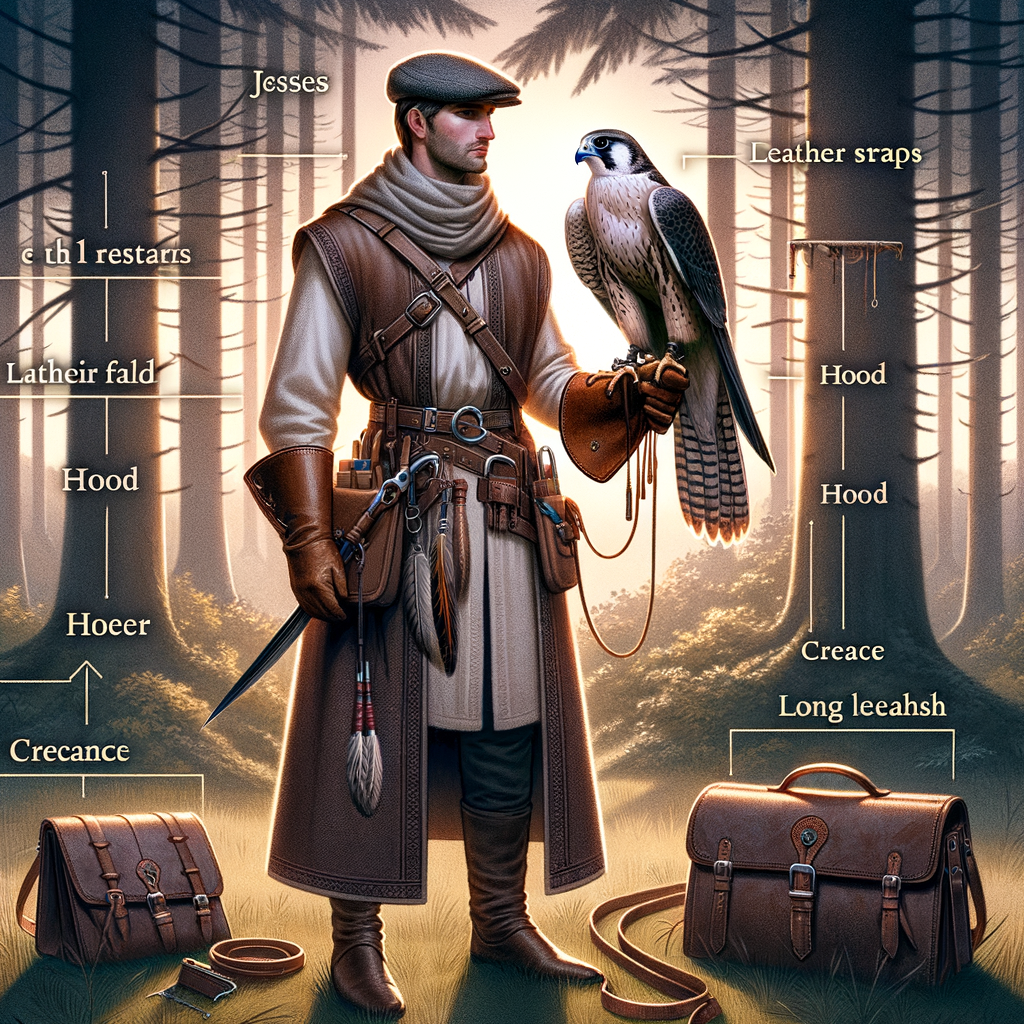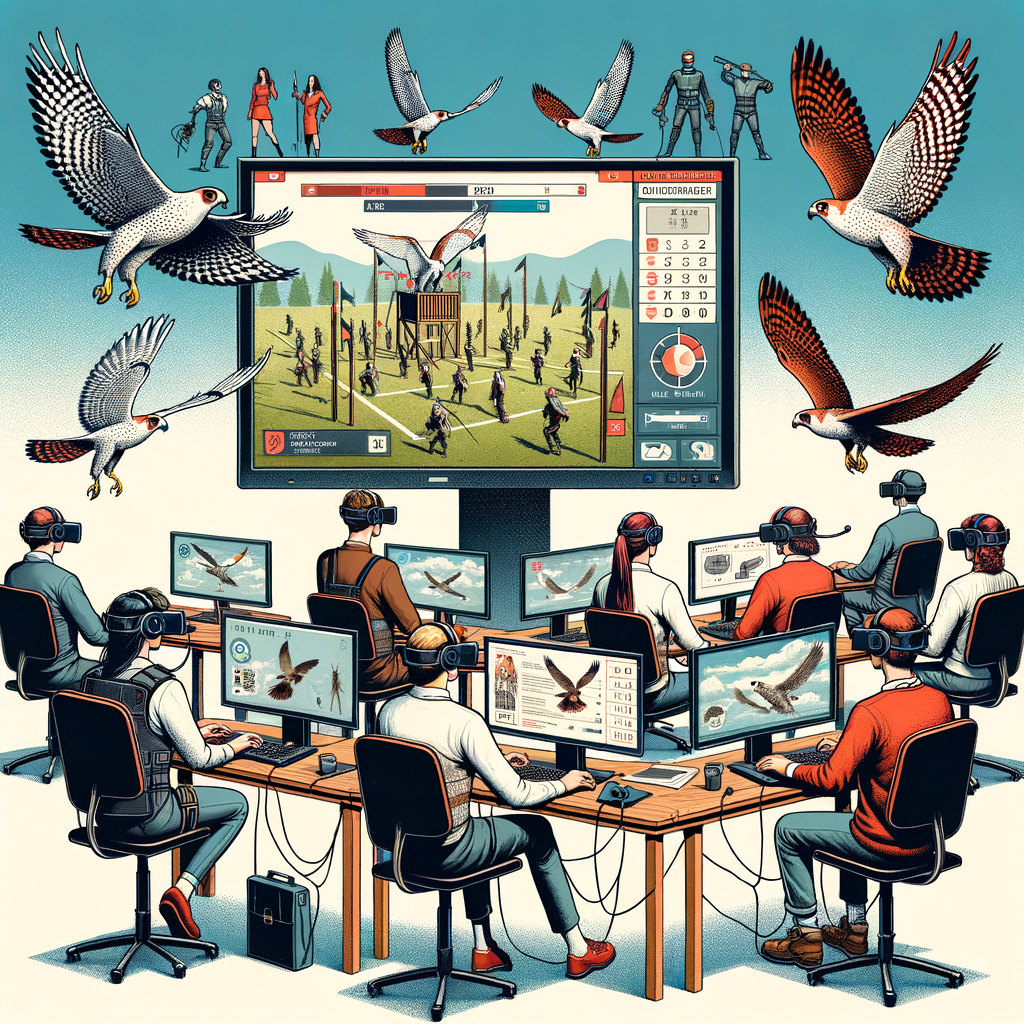Exciting Falconry Insights
- Falconer: Someone who trains and hunts with falcons.
- Eyass: A young bird taken from the nest to be trained.
- Mews: The place where falcons are kept.
- Lure: A tool used to train and exercise falcons by mimicking prey.
- Hood: A headcover for falcons to keep them calm.
- Jess: Leather straps attached to a falcon’s legs for control during training.
- Rouse: When a falcon shakes its feathers, indicating it’s healthy and content.
- Imping: The process of repairing damaged feathers on a falcon.
Explore these fascinating terms and deepen your understanding of the ancient and captivating art of falconry!
Falconry Terms and Definitions: Dive Into the Fascinating World of Falcons
Have you ever watched a majestic falcon glide through the sky and wondered about the amazing world of falconry? Here at Learn Falconry, we’ve taken our wings to soar across the globe, sharing our love and knowledge of this ancient art. But before you can call yourself a falconry enthusiast, you’ll need to settle in and learn some key terms and definitions.
Imagine you’ve just set foot in a cozy Irish pub. The air is thick with the scent of hearty stew and the sound of cheerful conversation. You hear tales of brave knights and their loyal falcons, tales that have been passed down for centuries. Now, think about how understanding each word and phrase in these stories makes the whole experience richer and more engaging.
Just like a well-told Irish tale, falconry has its own unique language. Knowing these terms will make you feel like you’re part of an exclusive club, opening doors to deeper insights and more meaningful connections with fellow falconers. Plus, it’s just plain fun to see the look on someone’s face when you casually drop terms like “jesses” or “mews” into conversation!
In this article, we’ll break down these fascinating terms in a way that’s easy to grasp and enjoyable to read. By sticking with us, you’ll be well on your way to becoming a knowledgeable falconer, ready to share your passion with friends and family. So grab a seat and let’s get started on this exciting journey together.
Understanding Falconry Terms: A Comprehensive Falconry Glossary
Welcome to the captivating world of falconry! If you’re just starting with this ancient practice or want to deepen your knowledge, you’ve come to the right place. Understanding falconry terms and vocabulary is crucial for anyone involved in training and caring for these magnificent birds of prey. This guide is your go-to resource for falconry terminology.
What are the Falconry Terms?
Falconry, like any specialized field, has its own set of terms and phrases. These words help falconers communicate precisely about the different aspects of their practice. Here, we’ll define some essential falconry terms to get you started. Each term is a key piece of the falconry vocabulary you’ll need to know.
Essential Falconry Terms
- Accipiter: A group of hawks with short wings and long tails used for hunting in wooded areas. Learn more about their habitats on our species of falcons page.
- Bate: When a falcon attempts to fly from a perch or the falconer’s glove while still tethered. Bating can be reduced through proper training techniques, which you can explore here.
- Creance: A long, light cord used during training to allow a bird to fly a distance without the risk of losing it. Discover more about this technique here.
- Eyas: A young bird taken from the nest for the purpose of being trained in falconry. For more on training young falcons, visit this section.
- Falcon: Typically refers to female falcons, which are larger than males and more often used in falconry. Learn about the different species in our falconry species guide.
- Hood: A leather covering placed over a bird’s head to keep it calm during transport and training. Read more about different types of hoods here.
- Jesses: Leather straps fastened around a bird’s legs, used for better control. Get details about using jesses and other equipment here.
- Mews: The housing provided for the birds. It can be a shed, aviary, or a room in a building, specially designed to safely house birds of prey. For more on setting up mews, click here.
- Manning: The process of taming and accustoming a bird to human presence and activities. You can find more about manning techniques here.
- Quarry: The game that is hunted with the help of a falcon or hawk. Curious about what types of prey are suitable? Check out this article.
Discover More about Falconry
Exploring falconry vocabulary is just the beginning. To truly master the art of falconry, knowledge about its history, techniques, equipment, and conservation efforts are key. Learn more through these detailed resources:
- History of Falconry
- Falconry Equipment
- Training a Falcon
- Species of Falcons
- Falconry Techniques
- Legal Aspects of Falconry
- Falcon Health and Nutrition
- Modern Falconry
- Falconry and Conservation
By diving into these resources, you’ll gain a comprehensive understanding of all aspects of falconry. Whether you’re looking to get started or aiming to advance your skill set, these guides will provide you with the information you need.
Ready to immerse yourself in the fascinating world of falconry? Let’s get started with understanding these essential terms!
Fascinating Falconry Terms and Definitions
Falconry is a captivating sport that combines the beauty of wild raptors with human skill and training. To truly understand and appreciate falconry, it’s essential to know the specific terms and definitions commonly used by practitioners. Let’s dive into some key aspects of falconry vocabulary and concepts:
Falconry Terms Glossary
Birds and Their Anatomy
- Accipiter: Refers to short-winged hawks within the genus Accipiter.
- Eyas: A young raptor taken from its nest before it can fly.
- Falcon or Hen: A term used for female raptors.
- Tiercel: The male falcon.
- Cere: The soft, fleshy part at the base of a bird’s beak.
- Talons: The sharp claws of raptors used for catching prey.
Equipment and Handling
- Jesses: Leather straps used to restrain a hawk’s legs.
- Creance: A long, lightweight cord attached to jesses, used to prevent the bird from flying away during training.
- Aba: A cloth wrap used to calm a bird by immobilizing it.
- Aylmeri: A design for leather anklets and jesses created by Guy Aylmeri.
- Bal Chatri: A traditional trap used by raptor banders, rehabilitators, and falconers.
Training and Techniques
- Bate: The action of a bird attempting to fly from a leash or perch.
- Stoop: A high-speed dive used by falcons to capture prey from above.
- Hack: Temporarily releasing a raptor to the wild to allow it to adjust to the environment.
- Imp: Repairing broken feathers by splicing undamaged feathers to them.
- Lure: A man-made object resembling prey, used to call in and train the bird.
Falconry Licenses and Regulations
Types of Falconry Licenses
| License Type | Requirements | Permissions |
|---|---|---|
| Apprentice Class | Age 18+, passing score on falconry exam (80% or higher) | Possess one wild-caught passage Red Tailed Hawk, Red Shouldered Hawk, or Kestrel. |
| General Class | Completion of two years as an apprentice, four months of annual practice with wild raptors | Possess up to three raptors including wild-caught and captive-bred birds except Eagles. |
| Master Class | Five years of practice at General class level with own raptors | Possess up to five wild raptors and unlimited captive-bred raptors, including Eagles with appropriate permitting. |
Falconry Examination and Database
- Falconry Examination: A 2-hour exam featuring 100 multiple-choice questions covering raptor care, identification, health, and regulations. A passing score is 80%.
- Falconry Database: The 3-186A Falconry database, used by various stakeholders for tracking and regulatory purposes, with periodic maintenance such as the outage planned from August 1 to August 3, 2023.
Falconry Species
| Type | Example Species |
|---|---|
| Broadwings | Red-Tailed Hawks, Harris Hawks, Golden Eagles |
| Shortwings | Cooper’s Hawks, Goshawks, Sparrow Hawks |
| Longwings | Peregrine Falcons, Kestrels, Gyrfalcons, Sakers |
Falconry Health and Maintenance
- Coping: The process of trimming a raptor’s beak and talons to maintain health and effectiveness.
- Mutes: The term for raptor droppings, indicating the health status of the bird.
- Rangle: Feeding small stones to captive birds to aid in cleansing the stomach.
- Imp: A technique to repair damaged flight feathers by attaching sections of molted feathers.
Falconry Training
Falconers commence training by bonding with their birds and gradually introducing them to small game like squirrels and rabbits. This helps the raptors hone their natural hunting skills, ensuring they stay sharp and effective hunters. Successful training requires patience, dedication, and knowledge of the birds’ behaviors and needs.
Understanding these key aspects provides a window into the intricate world of falconry. These terms and definitions are foundational for anyone looking to explore this age-old practice.
Wrapping Up the World of Falconry Terms
Falconry is a captivating blend of tradition, skill, and a deep connection with magnificent birds of prey. Through our exploration of key terms and definitions, we’ve delved into the rich vocabulary that every falconer must know. Whether it’s understanding the different types of raptors, such as longwings, shortwings, and broadwings, or getting to grips with essential equipment like jesses, lures, and mews, these terms form the backbone of the falconry experience.
Learning about the training techniques and the care raptors require gives us an appreciation for the dedication and expertise involved in this ancient practice. From the excitement of a bird “stooping” in a high-speed dive to the meticulous task of “imping” a broken feather, each term unveils a new aspect of the falconer’s world.
As you move forward in your journey with falconry, remember that knowledge is power. By mastering these terms, you’ll be well-prepared to train, care for, and understand your raptor companions. Here at Learn Falconry, we’re excited to support you every step of the way, ensuring you have the right knowledge and skills to succeed. Happy falconing!
Common Questions About Falconry Terms & Definitions
Exciting Falconry Insights
- Falconer: Someone who trains and hunts with falcons.
- Eyass: A young bird taken from the nest to be trained.
- Mews: The place where falcons are kept.
- Lure: A tool used to train and exercise falcons by mimicking prey.
- Hood: A headcover for falcons to keep them calm.
- Jess: Leather straps attached to a falcon’s legs for control during training.
- Rouse: When a falcon shakes its feathers, indicating it’s healthy and content.
- Imping: The process of repairing damaged feathers on a falcon.
Explore these fascinating terms and deepen your understanding of the ancient and captivating art of falconry!
Falconry Terms and Definitions: Dive Into the Fascinating World of Falcons
Have you ever watched a majestic falcon glide through the sky and wondered about the amazing world of falconry? Here at Learn Falconry, we’ve taken our wings to soar across the globe, sharing our love and knowledge of this ancient art. But before you can call yourself a falconry enthusiast, you’ll need to settle in and learn some key terms and definitions.
Imagine you’ve just set foot in a cozy Irish pub. The air is thick with the scent of hearty stew and the sound of cheerful conversation. You hear tales of brave knights and their loyal falcons, tales that have been passed down for centuries. Now, think about how understanding each word and phrase in these stories makes the whole experience richer and more engaging.
Just like a well-told Irish tale, falconry has its own unique language. Knowing these terms will make you feel like you’re part of an exclusive club, opening doors to deeper insights and more meaningful connections with fellow falconers. Plus, it’s just plain fun to see the look on someone’s face when you casually drop terms like “jesses” or “mews” into conversation!
In this article, we’ll break down these fascinating terms in a way that’s easy to grasp and enjoyable to read. By sticking with us, you’ll be well on your way to becoming a knowledgeable falconer, ready to share your passion with friends and family. So grab a seat and let’s get started on this exciting journey together.
Understanding Falconry Terms: A Comprehensive Falconry Glossary
Welcome to the captivating world of falconry! If you’re just starting with this ancient practice or want to deepen your knowledge, you’ve come to the right place. Understanding falconry terms and vocabulary is crucial for anyone involved in training and caring for these magnificent birds of prey. This guide is your go-to resource for falconry terminology.
What are the Falconry Terms?
Falconry, like any specialized field, has its own set of terms and phrases. These words help falconers communicate precisely about the different aspects of their practice. Here, we’ll define some essential falconry terms to get you started. Each term is a key piece of the falconry vocabulary you’ll need to know.
Essential Falconry Terms
- Accipiter: A group of hawks with short wings and long tails used for hunting in wooded areas. Learn more about their habitats on our species of falcons page.
- Bate: When a falcon attempts to fly from a perch or the falconer’s glove while still tethered. Bating can be reduced through proper training techniques, which you can explore here.
- Creance: A long, light cord used during training to allow a bird to fly a distance without the risk of losing it. Discover more about this technique here.
- Eyas: A young bird taken from the nest for the purpose of being trained in falconry. For more on training young falcons, visit this section.
- Falcon: Typically refers to female falcons, which are larger than males and more often used in falconry. Learn about the different species in our falconry species guide.
- Hood: A leather covering placed over a bird’s head to keep it calm during transport and training. Read more about different types of hoods here.
- Jesses: Leather straps fastened around a bird’s legs, used for better control. Get details about using jesses and other equipment here.
- Mews: The housing provided for the birds. It can be a shed, aviary, or a room in a building, specially designed to safely house birds of prey. For more on setting up mews, click here.
- Manning: The process of taming and accustoming a bird to human presence and activities. You can find more about manning techniques here.
- Quarry: The game that is hunted with the help of a falcon or hawk. Curious about what types of prey are suitable? Check out this article.
Discover More about Falconry
Exploring falconry vocabulary is just the beginning. To truly master the art of falconry, knowledge about its history, techniques, equipment, and conservation efforts are key. Learn more through these detailed resources:
- History of Falconry
- Falconry Equipment
- Training a Falcon
- Species of Falcons
- Falconry Techniques
- Legal Aspects of Falconry
- Falcon Health and Nutrition
- Modern Falconry
- Falconry and Conservation
By diving into these resources, you’ll gain a comprehensive understanding of all aspects of falconry. Whether you’re looking to get started or aiming to advance your skill set, these guides will provide you with the information you need.
Ready to immerse yourself in the fascinating world of falconry? Let’s get started with understanding these essential terms!
Fascinating Falconry Terms and Definitions
Falconry is a captivating sport that combines the beauty of wild raptors with human skill and training. To truly understand and appreciate falconry, it’s essential to know the specific terms and definitions commonly used by practitioners. Let’s dive into some key aspects of falconry vocabulary and concepts:
Falconry Terms Glossary
Birds and Their Anatomy
- Accipiter: Refers to short-winged hawks within the genus Accipiter.
- Eyas: A young raptor taken from its nest before it can fly.
- Falcon or Hen: A term used for female raptors.
- Tiercel: The male falcon.
- Cere: The soft, fleshy part at the base of a bird’s beak.
- Talons: The sharp claws of raptors used for catching prey.
Equipment and Handling
- Jesses: Leather straps used to restrain a hawk’s legs.
- Creance: A long, lightweight cord attached to jesses, used to prevent the bird from flying away during training.
- Aba: A cloth wrap used to calm a bird by immobilizing it.
- Aylmeri: A design for leather anklets and jesses created by Guy Aylmeri.
- Bal Chatri: A traditional trap used by raptor banders, rehabilitators, and falconers.
Training and Techniques
- Bate: The action of a bird attempting to fly from a leash or perch.
- Stoop: A high-speed dive used by falcons to capture prey from above.
- Hack: Temporarily releasing a raptor to the wild to allow it to adjust to the environment.
- Imp: Repairing broken feathers by splicing undamaged feathers to them.
- Lure: A man-made object resembling prey, used to call in and train the bird.
Falconry Licenses and Regulations
Types of Falconry Licenses
| License Type | Requirements | Permissions |
|---|---|---|
| Apprentice Class | Age 18+, passing score on falconry exam (80% or higher) | Possess one wild-caught passage Red Tailed Hawk, Red Shouldered Hawk, or Kestrel. |
| General Class | Completion of two years as an apprentice, four months of annual practice with wild raptors | Possess up to three raptors including wild-caught and captive-bred birds except Eagles. |
| Master Class | Five years of practice at General class level with own raptors | Possess up to five wild raptors and unlimited captive-bred raptors, including Eagles with appropriate permitting. |
Falconry Examination and Database
- Falconry Examination: A 2-hour exam featuring 100 multiple-choice questions covering raptor care, identification, health, and regulations. A passing score is 80%.
- Falconry Database: The 3-186A Falconry database, used by various stakeholders for tracking and regulatory purposes, with periodic maintenance such as the outage planned from August 1 to August 3, 2023.
Falconry Species
| Type | Example Species |
|---|---|
| Broadwings | Red-Tailed Hawks, Harris Hawks, Golden Eagles |
| Shortwings | Cooper’s Hawks, Goshawks, Sparrow Hawks |
| Longwings | Peregrine Falcons, Kestrels, Gyrfalcons, Sakers |
Falconry Health and Maintenance
- Coping: The process of trimming a raptor’s beak and talons to maintain health and effectiveness.
- Mutes: The term for raptor droppings, indicating the health status of the bird.
- Rangle: Feeding small stones to captive birds to aid in cleansing the stomach.
- Imp: A technique to repair damaged flight feathers by attaching sections of molted feathers.
Falconry Training
Falconers commence training by bonding with their birds and gradually introducing them to small game like squirrels and rabbits. This helps the raptors hone their natural hunting skills, ensuring they stay sharp and effective hunters. Successful training requires patience, dedication, and knowledge of the birds’ behaviors and needs.
Understanding these key aspects provides a window into the intricate world of falconry. These terms and definitions are foundational for anyone looking to explore this age-old practice.
Wrapping Up the World of Falconry Terms
Falconry is a captivating blend of tradition, skill, and a deep connection with magnificent birds of prey. Through our exploration of key terms and definitions, we’ve delved into the rich vocabulary that every falconer must know. Whether it’s understanding the different types of raptors, such as longwings, shortwings, and broadwings, or getting to grips with essential equipment like jesses, lures, and mews, these terms form the backbone of the falconry experience.
Learning about the training techniques and the care raptors require gives us an appreciation for the dedication and expertise involved in this ancient practice. From the excitement of a bird “stooping” in a high-speed dive to the meticulous task of “imping” a broken feather, each term unveils a new aspect of the falconer’s world.
As you move forward in your journey with falconry, remember that knowledge is power. By mastering these terms, you’ll be well-prepared to train, care for, and understand your raptor companions. Here at Learn Falconry, we’re excited to support you every step of the way, ensuring you have the right knowledge and skills to succeed. Happy falconing!



